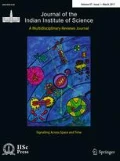Abstract
We present an approach for generating contextualized behavior recommendations from a large, data-driven, complex agent-based simulation. We extend a previous method for generating a summary description by decomposing the output of a simulation into a tree of causally-relevant states, and show how behavior recommendations can be generated by ranking these causally relevant states in terms of their impact on an outcome of interest. An end-user can provide a query specifying a partial state description, which is used to retrieve the appropriate set of states from the summary description. The structure of the tree is used to generate the contexts that differentiate the behavior recommendations. We apply our method to a very complex simulation of a disaster in a major urban area and present results for multiple queries.






Similar content being viewed by others
Notes
It may seem that similar to the CCSR algorithm9, we could potentially merge all clusters that lead to the same probability distribution over the final outcomes at each time step t. However, as shown by a toy example in Appendix C of11, merging clusters this way could potentially lead to suboptimal causal state sequences in the following time steps. Also, merging clusters would lead to nodes with multiple parents (i.e., simulation would be decompose into a graph that is not a tree) and the behavior recommendation algorithm described in Sect. 3.3, requires a tree structure to extract ancestor information (or historical context) for the clusters matching the query.
References
Atun F (2014) Understanding effects of complexity in cities during disasters. In: Walloth C, Gurr JM, Schmidt JA (eds) Understanding complex urban systems: multidisciplinary approaches to modeling. Springer, Switzerland, pp 51–66
Chandan S, Saha S, Barrett C, Eubank S, Marathe A, Marathe M, Swarup S, Vullikanti AK (2013) Modeling the interactions between emergency communications and behavior in the aftermath of a disaster. In: The international conference on social computing, behavioral-cultural modeling, and prediction (SBP). Washington DC, USA
Parikh N, Swarup S, Stretz PE, Rivers CM, Lewis BL, Marathe MV, Eubank SG, Barrett CL, Lum K, Chungbaek Y (2013) Modeling human behavior in the aftermath of a hypothetical improvised nuclear detonation. In: Proceedings of the international conference on autonomous agents and multiagent systems (AAMAS). Saint Paul, MN, USA
Parikh N, Marathe MV, Swarup S (2016) Summarizing simulation results using causally-relevant states. In: Osman N, Sierra C (eds) Autonomous agents and multiagent systems: AAMAS 2016 workshops, visionary papers, no. 10003 in LNAI, pp 88–103. Springer
Crutchfield JP, Young K (1989) Inferring statistical complexity. Phys Rev Lett 63(2):105–108
Shalizi CR, Crutchfield JP (2001) Computational mechanics: pattern and prediction, structure and simplicity. J Stat Phys 104(3/4):817–879
Crutchfield JP, Ellison CJ, Mahoney JR (2009) Time’s barbed arrow: irreversibility, crypticity, and stored information. Phys Rev Lett 103(9):094101
Ellison CJ, Mahoney JR, Crutchfield JP (2009) Prediction, retrodiction, and the amount of information stored in the present. J Stat Phys 136(6):1005–1034
Shalizi CR, Shalizi KL (2004) Blind construction of optimal nonlinear recursive predictors for discrete sequences. In: Chickering M, Halpern J (eds) Proceedings of the twentieth conference on uncertainty in artificial intelligence, pp 504–511. Banff, Canada
Rabiner L, Juang B (1986) An introduction to hidden markov models. IEEE ASSP Magaz 3(1):4–16. https://doi.org/10.1109/MASSP.1986.1165342
Parikh N (2017) Behavior modeling and analytics for urban computing: a synthetic information-based approach. Ph.D. thesis, Virginia Polytechnic Institute and State University
Barrett C, Bisset K, Chandan S, Chen J, Chungbaek Y, Eubank S, Evrenosoğlu Y, Lewis B, Lum K, Marathe A, Marathe M, Mortveit H, Parikh N, Phadke A, Reed J, Rivers C, Saha S, Stretz P, Swarup S, Thorp J, Vullikanti A, Xie D (2013) Planning and response in the aftermath of a large crisis: an agent-based informatics framework. In: Pasupathy R, Kim SH, Tolk A, Hill R, Kuhl ME (eds) Proceedings of the 2013 winter simulation conference
Barrett C, Beckman R, Berkbigler K, Bisset K, Bush B, Campbell K, Eubank S, Henson K, Hurford J, Kubicek D, Marathe M, Romero P, Smith J, Smith L, Speckman P, Stretz P, Thayer G, Eeckhout E, Williams MD (2001) TRANSIMS: transportation analysis simulation system. Tech. Rep. LA-UR-00-1725, Los Alamos National Laboratory Unclassified Report
Goldman CV, Zilberstein S (2008) Communication-based decomposition mechanisms for decentralized MDPs. J Artif Int Res 32(1):169–202
Sutton R, Precup D, Singh S (1999) Between MDPs and semi-MDPs: a framework for temporal abstraction in reinforcement learning. Artif Intell 112(1–2):181–211
Parikh N, Hayatnagarkar HG, Beckman RJ, Marathe MV, Swarup S (2016) A comparison of multiple behavior models in a simulation of the aftermath of an improvised nuclear detonation. Autonomous Agents Multi-agent Syst 30(6):1148–1174
Swarup S (2019) Adequacy: what makes a simulation good enough? In: Proceedings of the spring simulation conference (SpringSim). Tucson, AZ
Acknowledgements
We thank our colleagues in the Network Systems Science and Advanced Computing Division at the Biocomplexity Institute and Initiative at the University of Virginia for many interesting discussions.
Author information
Authors and Affiliations
Corresponding author
Ethics declarations
Conflicts of Interest
On behalf of all authors, the corresponding author states that there is no conflict of interest.
Additional information
Publisher's Note
Springer Nature remains neutral with regard to jurisdictional claims in published maps and institutional affiliations.
This work was partially supported by University of Virginia Strategic Investment Fund award number SIF160, and Defense Threat Reduction Agency (DTRA) under Contract No. HDTRA1-19-D-0007.
Rights and permissions
About this article
Cite this article
Parikh, N., Marathe, M.V. & Swarup, S. Contextualized Behavior Recommendation from Complex Agent-Based Simulations of Disasters. J Indian Inst Sci 101, 403–417 (2021). https://doi.org/10.1007/s41745-021-00256-y
Received:
Accepted:
Published:
Issue Date:
DOI: https://doi.org/10.1007/s41745-021-00256-y




